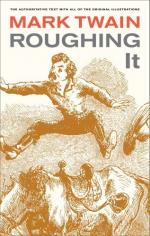And now there can be no fitter occasion than the present to pronounce a left-handed blessing upon the man who invented the American saddle. There is no seat to speak of about it—one might as well sit in a shovel —and the stirrups are nothing but an ornamental nuisance. If I were to write down here all the abuse I expended on those stirrups, it would make a large book, even without pictures. Sometimes I got one foot so far through, that the stirrup partook of the nature of an anklet; sometimes both feet were through, and I was handcuffed by the legs; and sometimes my feet got clear out and left the stirrups wildly dangling about my shins. Even when I was in proper position and carefully balanced upon the balls of my feet, there was no comfort in it, on account of my nervous dread that they were going to slip one way or the other in a moment. But the subject is too exasperating to write about.
A mile and a half from town, I came to a grove of tall cocoanut trees, with clean, branchless stems reaching straight up sixty or seventy feet and topped with a spray of green foliage sheltering clusters of cocoa-nuts—not more picturesque than a forest of collossal ragged parasols, with bunches of magnified grapes under them, would be.
I once heard a gouty northern invalid say that a cocoanut tree might be poetical, possibly it was; but it looked like a feather-duster struck by lightning. I think that describes it better than a picture—and yet, without any question, there is something fascinating about a cocoa-nut tree—and graceful, too.
About a dozen cottages, some frame and the others of native grass, nestled sleepily in the shade here and there. The grass cabins are of a grayish color, are shaped much like our own cottages, only with higher and steeper roofs usually, and are made of some kind of weed strongly bound together in bundles. The roofs are very thick, and so are the walls; the latter have square holes in them for windows. At a little distance these cabins have a furry appearance, as if they might be made of bear skins. They are very cool and pleasant inside. The King’s flag was flying from the roof of one of the cottages, and His Majesty was probably within. He owns the whole concern thereabouts, and passes his time there frequently, on sultry days “laying off.” The spot is called “The King’s Grove.”
Near by is an interesting ruin—the meagre remains of an ancient heathen temple—a place where human sacrifices were offered up in those old bygone days when the simple child of nature, yielding momentarily to sin when sorely tempted, acknowledged his error when calm reflection had shown it him, and came forward with noble frankness and offered up his grandmother as an atoning sacrifice—in those old days when the luckless sinner could keep on cleansing his conscience and achieving periodical happiness as long as his relations held out; long, long before the missionaries braved a thousand privations to come




